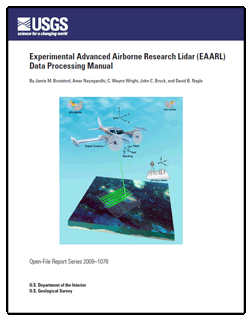Open-File Report 2009–1078

IntroductionThe Experimental Advanced Airborne Research Lidar (EAARL) is an example of a Light Detection and Ranging (Lidar) system that utilizes a blue-green wavelength (532 nanometers) to determine the distance to an object. The distance is determined by recording the travel time of a transmitted pulse at the speed of light (fig. 1). This system uses raster laser scanning with full-waveform (multi-peak) resolving capabilities to measure submerged topography and adjacent coastal land elevations simultaneously (Nayegandhi and others, 2009). This document reviews procedures for the post-processing of EAARL data using the custom-built Airborne Lidar Processing System (ALPS). ALPS software was developed in an open-source programming environment operated on a Linux platform. It has the ability to combine the laser return backscatter digitized at 1-nanosecond intervals with aircraft positioning information. This solution enables the exploration and processing of the EAARL data in an interactive or batch mode. ALPS also includes modules for the creation of bare earth, canopy-top, and submerged topography Digital Elevation Models (DEMs). The EAARL system uses an Earth-centered coordinate and reference system that removes the necessity to reference submerged topography data relative to water level or tide gages (Nayegandhi and others, 2006). The EAARL system can be mounted in an array of small twin-engine aircraft that operate at 300 meters above ground level (AGL) at a speed of 60 meters per second (117 knots). While other systems strive to maximize operational depth limits, EAARL has a narrow transmit beam and receiver field of view (1.5 to 2 milliradians), which improves the depth-measurement accuracy in shallow, clear water but limits the maximum depth to about 1.5 Secchi disk depth (~20 meters) in clear water. The laser transmitter [Continuum EPO-5000 yttrium aluminum garnet (YAG)] produces up to 5,000 short-duration (1.2 nanosecond), low-power (70 microjoules) pulses each second. Each pulse is focused into an illumination area that has a radius of about 20 centimeters on the ground. The pulse-repetition frequency of the EAARL transmitter varies along each across-track scan to produce equal cross-track sample spacing and near uniform density (Nayegandhi and others, 2006). Targets can have varying physical and optical characteristics that cause extreme fluctuations in laser backscatter complexity and signal strength. To accommodate this dynamic range, EAARL has the real-time ability to detect, capture, and automatically adapt to each laser return backscatter. The backscattered energy is collected by an array of four high-speed waveform digitizers connected to an array of four sub-nanosecond photodetectors. Each of the four photodetectors receives a finite range of the returning laser backscatter photons. The most sensitive channel receives 90% of the photons, the least sensitive receives 0.9%, and the middle channel receives 9% (Wright and Brock, 2002). The fourth channel is available for detection but is not currently being utilized. All four channels are digitized simultaneously into 65,536 samples for every laser pulse. Receiver optics consists of a 15-centimeter-diameter dielectric-coated Newtonian telescope, a computer-driven raster scanning mirror oscillating at 12.5 hertz (25 rasters per second), and an array of sub-nanosecond photodetectors. The signal emitted by the pulsed laser transmitter is amplified as backscatter by the optical telescope receiver. The photomultiplier tube (PMT) then converts the optical energy into electrical impulses (Nayegandhi and others, 2006). In addition to the full-waveform resolving laser, the EAARL sensor suite includes a down-looking 70-centimeter-resolution Red-Green-Blue (RGB) digital network camera, a high-resolution color infrared (CIR) multispectral camera (14-centimeter-resolution), two precision dual-frequency kinematic carrier-phase global positioning system (GPS) receivers, and an integrated gyroscope-based, miniature digital inertial measurement unit (IMU) that provides accurate attitude information (Nayegandhi and others, 2006). Laser error depends on the type of surface being mapped, which can range from a few centimeters in open canopies to several meters in closed and sloping terrains. Recent studies have shown that EAARL elevation root mean square errors (RMSE) range from 10 to 14 centimeters for submerged topography to 16 to 20 centimeters for sub-canopy topography. The RMSE is also highly dependent on GPS satellite configuration and lidar sampling angles. A high RMSE occurs during poor satellite configuration and large sampling angles that usually happen at the edge of the swath (Nayegandhi and others, 2009). |
Posted July 2009 Part or all of this report is presented in Portable Document Format (PDF); the latest version of Adobe Reader or similar software is required to view it. Download the latest version of Adobe Reader, free of charge. |
Bonisteel, J.M., Nayegandhi, Amar, Wright, C.W., Brock, J. C., and Nagle, D.B., 2009, Experimental Advanced Airborne Research Lidar (EAARL) Data Processing Manual: U.S. Geological Survey Open-File Report, 2009-1078, 38p.
Introduction
Processing of Raw EAARL Data
Filtering
Datum Conversion
Quarter Quadrangle
Airborne Topographic Mapper Data Processing
Manual Filtering/Editing
Quality Control
Product Creation
References Cited
Appendix A. ALPS Installation
Appendix B. Virtual Network Computing
Appendix C. Typical EAARL Raw Directory Setup
Appendix D. Major EAARL Data Processing Steps
Appendix E: Additional Processing Information
List of Abbreviations and Acronyms